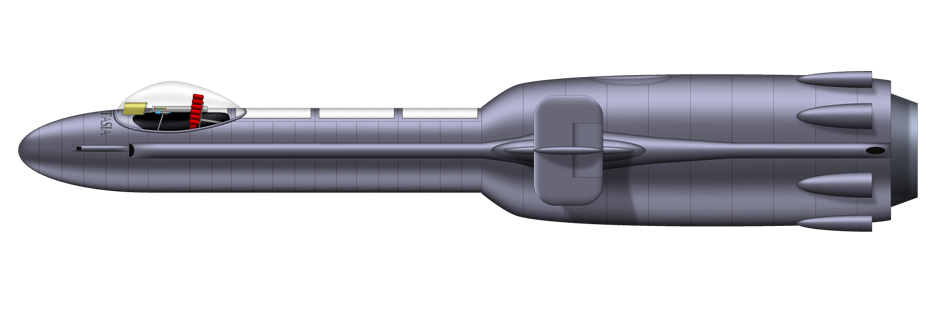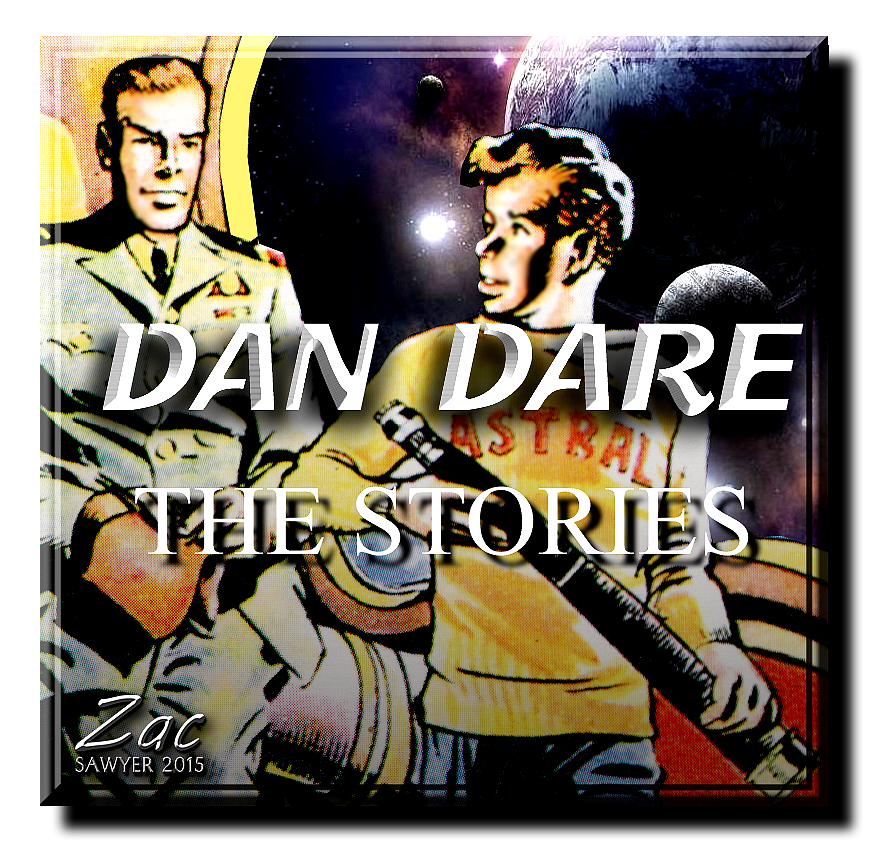 |
| © Copyright Zac Sawyer 2015 |
DAN DARE -THE STORIES
to view images full size open image in a new tab
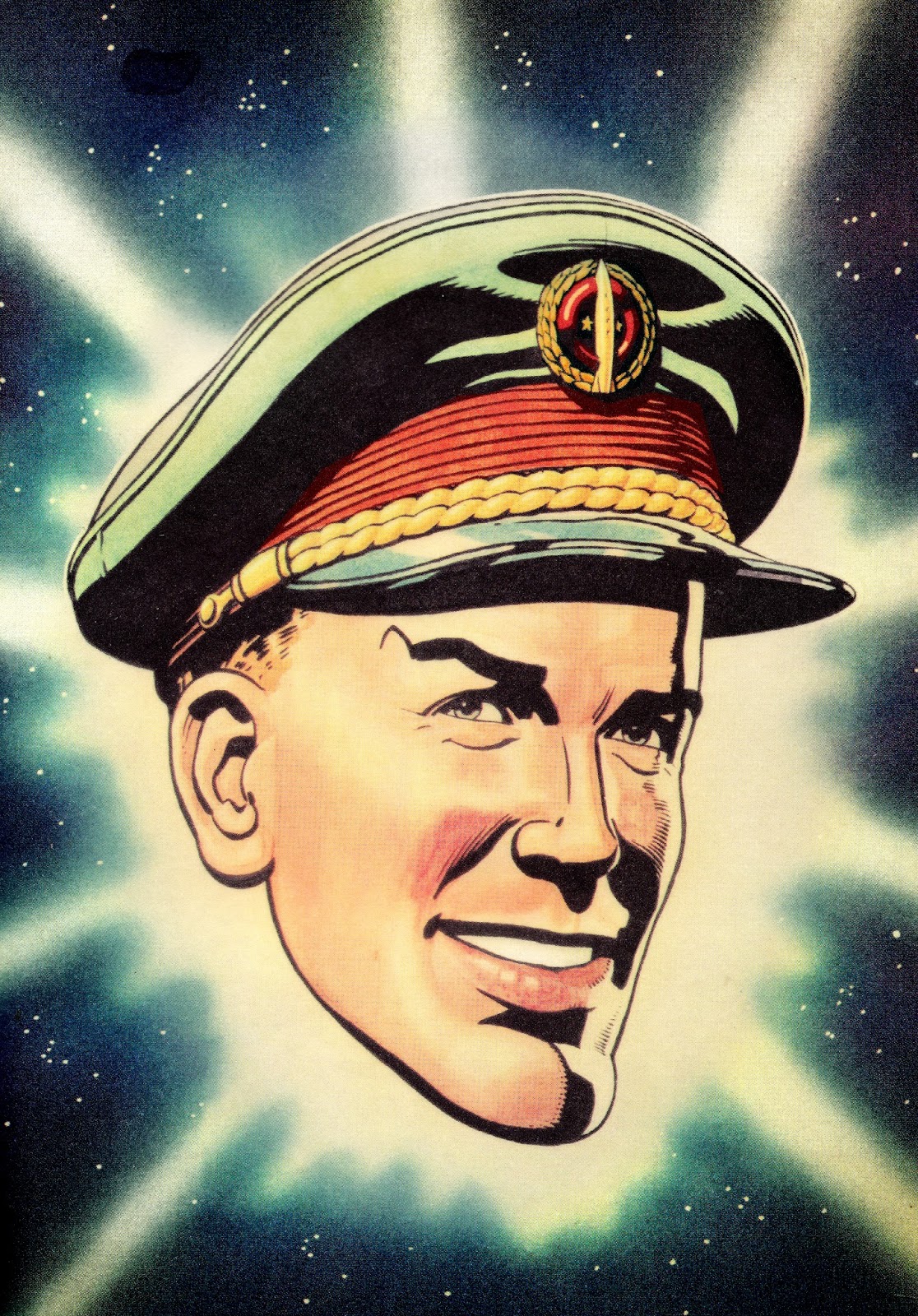 |
| Dan Dare |
 |
© Copyright Zac Sawyer 2015
Frank Hampson |
Dan Dare is a British science fiction comic hero, created by illustrator Frank Hampson, who also wrote the first stories, that is, the 'Venus' and 'Red Moon' stories, and a complete story-line for 'Operation Saturn'.
Dare appeared in the 'Eagle' comic story 'Dan Dare, Pilot of the Future' in 1950, and also dramatized seven times a week on Radio Luxembourg.
The stories were set in the late 1990s, but the dialogue and manner of the characters is reminiscent of British films of the 1950s.
Dan Dare was distinguished by its long, complex story-lines snappy dialogue, and meticulously illustrated comic-strip artwork by Frank Hampson, and other artists, including Harold Johns, Don Harley, Bruce Cornwell, Greta Tomlinson, Frank Bellamy and Keith Watson.
Dan Dare appeared on the cover of the first issue of the weekly comic strip magazine, Eagle, on 14 April 1950.
'The Venus Story'
The first Dan Dare story has no official name.
In view of its subject, it’s usually referred to as ‘The Venus Story’ or ‘Voyage to Venus’, ‘The Venus Story’ lasted almost eighteen months, the longest story ever to appear in Eagle, and possibly the longest story ever to appear in a British boys comic.
It was originated by Frank Hampson, who not only drew but also wrote (without compensation) the first ten episodes on his own.
Hulton then provided a writer, Guy Treece, who continued the story for six weeks before taking Hampson to lunch and charmingly advising that he had no idea what to do next: having been classically trained, he couldn't possibly do more!
Hampson soldiered on with the majority of the writing, occasionally paying other writers out of his own pocket, but he would not find a reliable writer in whom he could trust on a regular basis until 1954, when Alan Stranks, already an Eagle veteran, would take over.
Stranks would later comment that Hampson threw away an awful lot of material in 'The Venus Story', and that he could have made the same story last for five years !
At the same time as Treece made his contribution, Hampson had begun assembling his studio.
'The Venus Story' has first to set-up Dan Dare, and his cast of regular supporting characters and, more importantly, the world in which they lived.
Though Hampson had no prior experience of building a story, or a world, he managed all of this with an instinctive skill, and an eye for building in exposition.
Part of Hampson’s success was in his ability to construct a story that, whilst set in a future that was close enough for each reader to imagine himself growing into, was also keyed to their current experience.
Dan is the 'Pilot of the Future', immediately linking him to the dashing RAF pilots of the recent War, who were still heroes to small boys.
And his task is to eliminate Food rationing, an issue that still plagued Britain five years after the end of the War, not being abolished until 1951.
The theme joined dismal present to colorful future, a future that Hampson crammed dozens of fantastic futuristic devices into: fantastic but utterly plausible and realistic.
The story begins with the ‘Kingfisher’s flight to Venus, via this future’s dominant technology, Impulse Wave Engines, which would take seven days, automatically drawing its audience back for week 2 when, that dull and mundane week of waiting done, they could find out what happened when 'Kingfisher' reached the clouded planet.
However, to the frustration of a control tower that could do nothing, 'Kingfisher' is destroyed in a space explosion, exactly as its predecessors were, and Sir Hubert and Colonel Dare must fly immediately to a World Cabinet meeting, at which the Controller will report, and the Chief Pilot will give his quick-witted (and of course correct) theory of what is happening and how it can be overcome.
Which is that Venus is shielded by a barrier that causes explosions in Impulse Wave Engines, which can be by-passed by approaching in old style Chemical Motor Rockets.
Dan’s theory is accepted, a fourth expedition is ordered, and this time Dan Dare has his way: it will be under his command.
He won’t be left out any longer.
We are then to introduced the rest of the characters, as they assemble to crew under Colonel Dare, but before we meet the men (and woman) who will be regulars in the strip for the next decade, we must pause to examine that one essential cast member, the other ranks Spaceman who will be the most loyal and most consistent member of the team for the entirety of the run, Spaceman First Class Albert Fitzwilliam Digby, of Wigan.
The faithful Digby, Dan’s batman (i.e., personal servant).
Short where Dan is tall, prematurely white-haired (with a quiff) where Dan has smooth, well-brushed brown hair, tubby where Dan is slim, Dig is the physical opposite of his Colonel just as he is the other pole in the series.
Before long, Hampson would break down his two principal characters into an easy, aphoristic line: “Dan Dare was the man I dreamed of being, Digby the man I was afraid I was.”
But the next member of the cast that would dominate the early years of the series had already been introduced before Dig. Sir Hubert Gascoigne Guest, Controller of Space-fleet, was a veteran of space travel
Hampson completed his cast in the fourth week of the story, jumping ahead three months.
Spacefleet Construction Branch had knocked itself out, completing three two-seater scout ships with old-fashioned chemical rocket motors.
These would be transported to Venus orbit, outside the presumed Barrier zone, where Dare’s expedition would then launch and try to penetrate the Barrier.
Three times two made six: Dan and Digby counted as two of these, and Sir Hubert, despite being over the age for active service, insisted on forming a member of the party: as a veteran of the early days of spaceflight, he wasn't going to miss this nostalgic chance.
This still left three.
Two were accounted for quickly.
Dan had arranged for two of Spacefleet’s most-accomplished pilots, and his two closest service friends, to be assigned to the mission.
Pilot Captains Pierre Lafayette and Henry Brennan “Hank” Hogan emphasized the international element of the future, of the World Government.
Borders may have been abolished, but Pierre and Hank were as distinctively French and American as their names suggested, the one with his slightly tubby appearance and his little Gallic mustache, the other a Texan with an exuberant disdain for authority, and little wire-rimmed glasses: features that would easily identify who was who in the plentiful scenes in spacesuits.
Hank and Pierre would be mainstays of the series for the first five years, missing only from Marooned on Mercury.
They were easy-going, reliable lieutenants, cheerfully insulting each other along the way, and occasionally causing accidents.
But Hank and Pierre’s main weakness was that they were only lieutenants: they lacked the initiative to take independent action when they were removed from their commander, as we would see later this story.
There was one more almost indispensable member of the series, the last to be introduced in those early weeks, and the most usual of all in the context of a boy’s comic.
Professor Peabody was a Botanist, directed to the mission by the World Government to carry out the necessary tests to determine if food for Earth could be grown in Venusian soils.
But the Professor was not the ancient greybeard that the team expected.
The Professor turned out to be a capable, cool, slim red-headed young woman in her late twenties, Professor Jocelyn Mabel Peabody.
And she was an attractive young woman to boot, though not portrayed as a knock-out of any kind (as Robert Hampson modelled Sir Hubert, the Professor’s template was the studio’s youngest member, Greta Tomlinson).
A woman in a boy’s comic! And not just a woman but an independent highly-qualified woman who was determined to look out for herself and perfectly capable of so doing.
In all the ways Dan Dare and Eagle broke with convention, in the early Fifties, Miss Peabody was probably the most radical.
 |
© Copyright Zac Sawyer 2015
The Spacceship 'Ranger' |
The spaceship ‘Ranger’ conveys the team to Venus orbit by impulse power, and the expedition prepares for Venus-fall.
The team split themselves up naturally: Dan and Dig in ship 1, Hank and Pierre in ship 2 and the odd couple, Sir Hubert and the Professor in ship 3. How else it could have been done was irrelevant: Sir Hubert insisted on accompanying the Professor, in order to keep an eye on the clearly unreliable female.
So Dan and Dig made the first approach, proving Dan’s theory, however, by a clearly understandable design oversight, the ships had been provided with standard issue Impulse wave radios.
This blew, cutting off communications and forcing a crash-landing on Venus, in a tropical belt of strange and wonderful vegetation, waters and fauna.
This, as much as the story itself, is what Frank Hampson excelled at, and was what made Dan Dare so memorable over so many years.
Hampson imagined into being, in an utterly convincing manner, the surface of an alien planet.
Not so alien that it was utterly unrecognizable, without logic, but coherent: a wonderland for the reader’s imagination.
Meanwhile, Dan and Digby were marooned, unable to escape or even earn their team-mates about the risk.
All they could do was set off towards the planned rendezvous point at the equator.
Back in space, it is the logical Pierre who divines the reason behind Dan’s radio silence and, after the radios are removed back on ‘Ranger’, he and Hank set off from the second attempt.
But when Sir Hubert announces his intention, should they fail, to return the Professor to the ship and proceed alone, Miss Peabody, who is a fully qualified space pilot and is at the controls, defies orders and sends no 3 ship in pursuit.
We leave them for now and return to Dan and Dig on the Venus surface.
The air, it appears, is breathable, though their suits’ atmosphere testers don’t agree.
But their first encounters with Venusian life are imminent.
First they are captured by blue-skinned primitives, (later revealed to be Atlantines) human in shape, save for their thick red hair and a pronounced bump on their forehead.
These primitives take then to a base controlled by a technologically superior race, green-skinned, hairless, seven foot tall dressed in near identical costumes.
 |
© Copyright Zac Sawyer 2015
The Infamous Mekon
|
These are the Treens, the dominant life-form of the northern hemisphere of Venus, cold, calculating, scientific, of lizard-like descent.
In due course, the Treens will be found to be led by their Chief Scientist, the infamous Mekon.
The blue-skinned people are the Treens’ slaves.
They are Atlanteans, descendents of people 'stolen' from Earth a millennium ago, by the Treens, whose depredations led to the destruction of the great land barrier that preserved the vast inland valley where Atlantis lay, and which is now the Mediterranean Sea.
There is a third race on Venus, but we are not destined to meet them just yet.
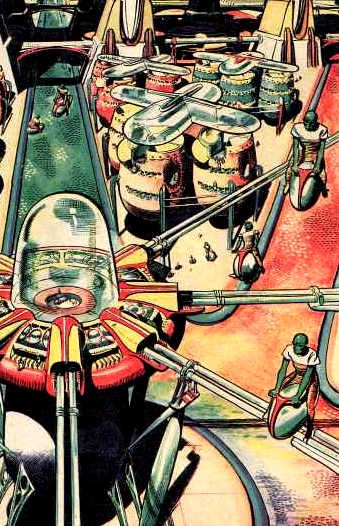 |
© Copyright Zac Sawyer 2015
Mekonta |
Dan and Dig are taken to the Treen capital, Mekonta, the first chance Hampson had to draw a full-page spread, sixteen weeks into Eagle and the series’ life. It is Mekonta, a fantastic yet logical creation, set in an artificial lagoon of multi-coloured water. It is a page that can be studied forever.
In the city, they learn that they will be subjected to scientific experiment. The Treens apparently know a great deal about Earth, and have plans to invade and take over the planet in order to scientifically rationalise it and its population. Furthermore, Dan and Dig are shown a broadcast of the other two ships of their expedition.
This is where the one significant failing of this story first appears. It’s at least heavily implied that what Dan and Dig see is happening live, yet their own experiences and journeys have taken the equivalent of a couple of Earth days, and no such lapse in time could possibly have happened to the other four members of the team. It could be that the Treen scientist is only showing a recording of what has already happened, but if this is so, it’s certainly not made in any way clear, and as the issue of time on the Venusian surface against time in space and on Earth will continue to be completely at odds, this is not an explanation I am prepared to accept.
to be continued.....
________________________________
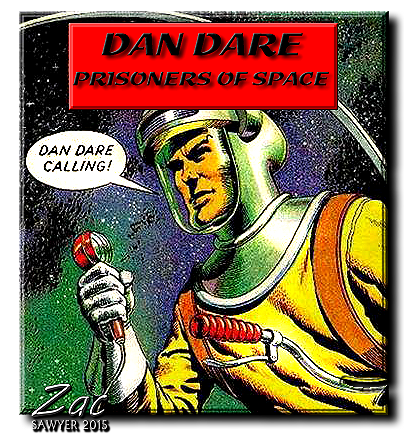 |
| © Copyright Zac Sawyer 2015 |
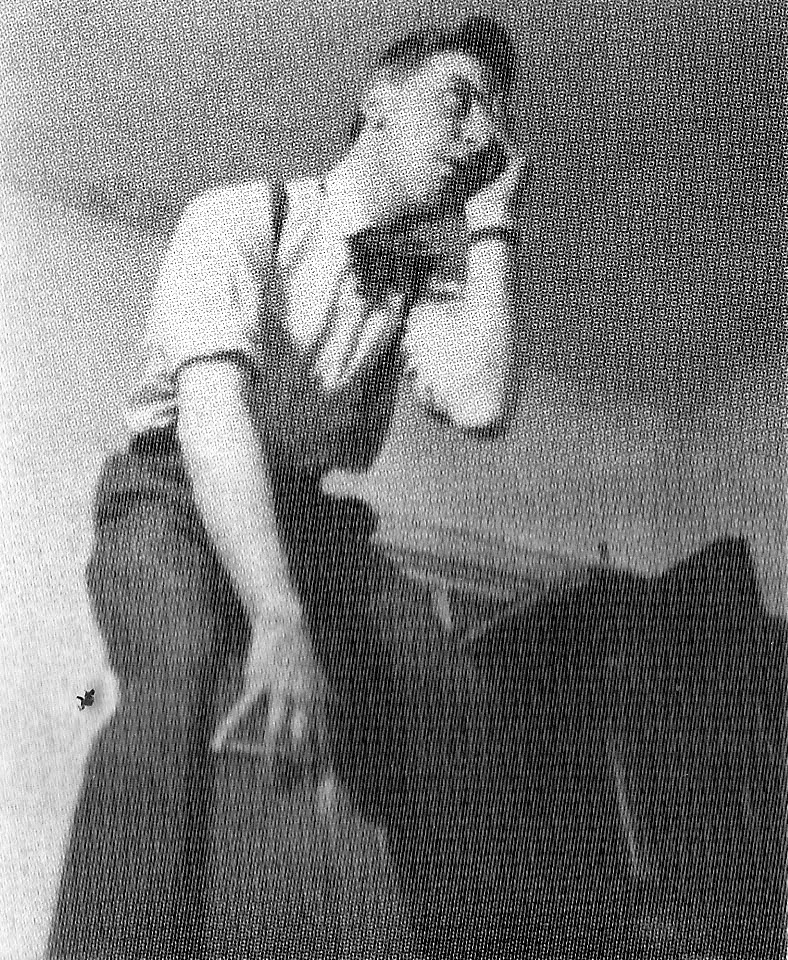 |
| Don Harley Posing |
This new story was principally drawn by Don Harley, and finished by Desmond Walduck, a freelance artist who had helped out in the closing weeks of 'Operation Saturn', and who was regarded as a safe pair of hands for work that couldn’t be encompassed by the Hampson studio.
Indeed, by the time 'Prisoners of Space' started, it was something of a stretch to call Hampson’s much-reduced team of assistants a ‘Studio’.
Eric Eden had gone, Bruce Sterling had gone (again), Harold Johns and Greta Tomlinson had been fired, Joyce Porter had married: all that was left was Don Harley and Joan Humphries.
The main question is who was responsible for the writing of 'Prisoners of Space', and it was probably Alan Stranks - his first Dan Dare story.
The story starts by introducing Astral College, Spacefleet’s cadet training school, and head boy Steve Valiant, along with his two best friends, and study mates Mark Straight and Tony Albright.
A far more important character is introduced on the second page, namely Junior Cadet ‘Flamer’ Spry.
‘Flamer’ – who will join the series regular supporting cast for the next six years – is the ineluctable evidence that Hampson was involved in at least the starting weeks of Prisoners of Space because ‘Flamer’, (who is given no real first name in the entire series), is based in some ways on Frank Hampson’s son, Peter, in a similar way to Sir Hubert being based on Frank's father, Robert. (Actually, less so, however, as Peter Hampson has commented that, whilst his father took Peter’s face and hair for ‘Flamer’, Cadet Spry’s body was based upon one of Peter’s classmates).
Cadet Spry, we quickly learn, is a precocious talent.
Dan Dare’s latest ship, a one-man craft nicknamed the ‘Performing Flea’ has just been taken off the secret list and ‘Flamer’ has already built a working model.
This model gets accidentally set-off in his absence by Cadet ‘Tubby’ Potts.
The mini-‘Flea’ almost prangs Sir Hubert, who is understandably testy about the whole thing.
Spry confesses, and is facing possible expulsion until Valiant alibis him as being in his study when the rocket went up.
Sir Hubert passes responsibility for punishment to Colonel Dare who, impressed by ‘Flamer’ (who he seems to be meeting for the first time), opts to ‘punish’ him by giving Spry and Valiant a tour of the real ‘Performing Flea’.
Thus far, the story may be seen as faintly comic, but Hampson also establishes a serious element to the background.
Venus Transport ships are going missing without explanation in the area of Station XQY which, by fortunate coincidence, is the destination of the ‘Performing Flea”s test flight: the course is pre-programmed into the Autopilot, which will enable Dare to pilot the ship alone – without even the faithful Digby – and the test flight will be the perfect cover for an investigation of that sector.
Here is where fate steps in to overturn the apple-cart.
Naturally, when Dan says he’ll show ‘Flamer’ and Steve round the ‘Performing Flea’, he means Digby will do it, under the watchful and disapproving eye of ‘Old Groupie’.
Groupie played a small part in 'Operation Saturn' as a madcap, ex-RAF type, piloting an air-taxi, but he’s now been taken on by Space-fleet as a civilian mechanic.
This leads directly into disaster.
Digby’s goes to make a cup of tea, and ‘Flamer’ is lying on the pilot’s couch, hands on the controls, dreaming of taking off
Suddenly grumpy old Groupie grabs his ankles and yanks him back.
Before he can let go, ‘Flamer’ has yanked the controls back as well: autopilot kicks in and the ‘Performing Flea’ is launched on course to Station XQY.
to be continued.....
_____________________________
'Marooned on Mercury'
This fourth story, the second longest single story in the entire canon, takes Dan and Co deeper into space than they had ever been, and introduces another race of aliens to the teeming life of Earth’s Solar System, and demonstrate another step forward in Hampson’s evolution as an artist.
But Hampson’s health would still play a crucial part in the telling of this story.
'Marooned on Mercury' sees Dan, Digby, the Professor, Sondar, and an Atlantine Space-Cadet, Urb, survive the fireball of destruction that accompanied the Red Moon’s destruction to find themselves stranded, believed dead, on the innermost planet, Mercury.
He had already requested Walkden Fisher – famous for the weekly exploded drawings in Eagle that turned thousands of boys’ minds towards engineering – to make model Mercurian landscapes for him, to use in depicting the planet nearest the sun, though Hampson had not liked the results, which did not match his inner visions.
Mercurian City - Marooned on Mercury
And he had already decided that once Dan and co had survived their landing, courtesy of the Mercurians themselves, they would discover an old enemy plotting revenge: the Mekon.
Then disaster struck.
Hampson pushed his studio hard, but he pushed himself even harder.
He’d had to step back a couple of times during ‘The Venus Story’, missing the last four weeks.
But now the self-imposed workload caught up with him with a vengeance.
An inner-ear infection, destroying his balance, coupled with a diagnosis of exhaustion resulted in an order of bed-rest, and no activity under any circumstances.
Dorothy, Frank's wife, enforced this, but only two weeks into the story, 'Marooned on Mercury' had lost its creator.
So far as the art was concerned, there was a simple solution.
Harold Johns, Hampson’s good friend and senior assistant, took over principal art, working in close collaboration with Greta Tomlinson.
As for the script, the Reverend Marcus Morris turned to the seemingly unlikely figure of the Reverend Chad Varah.
Varah had been a friend of Morris for some years.
Like Morris, he was the Vicar of a Lancashire parish, in Blackburn, and a founder of Morris’s Society for Christian Publicity.
At this early stage of his carer, Varah had a sideline as the writer of short adventure stories for boys, several of which had been published in the early days of Eagle.
In the circumstances, given the short notice, he was the best available choice.
Whatever Hampson had planned for Marooned on Mercury, assuming he had anything planned as yet, was all in his head and Varah had to hit the ground cold. As for Johns and Tomlinson, they were more than grateful for Fisher’s models.
The major problem with 'Marooned on Mercury' is that Varah simply did not have Hampson’s gift for making it up as he went along.
The actual story has nothing intrinsically wrong about it, but the actual week-by-week tale is choppy and disjointed, as if Varah was not able to sustain extended elements of the story in the way Hampson had with the two previous tales.
The story is that, when the Mekon escaped from Venus following his overthrow, he sought refuge on Mercury, where he has dominated a basically pacifist society.
Among the Mekon’s resources is a group of Earthmen, in fact the Captain and crew of 'Kingfisher', the impulse drive ship destroyed in Eagle’s second issue, now revealed to have survived and been prisoners in Mekonta throughout ‘The Venus Story’.
The 'Kingfisher' crew are unaware that they are working for the Mekon: they were released from prison by Treens claiming to be rebels against the Mekon, who are working towards rejoining a war they don’t know has been won, to oppose him.
On Mercury, the Mekon has discovered a plant-form harmless to Mercurians, but fatal to Earthmen and Treens.
From this, he has synthesized a gaseous substance which is referred to in the story as 'Panthanaton' (Latin: All-Deathbringer).
His plan was to use Captain D’Arcy and his crew to fly a spaceship to Venus, relying on their being allowed through the planetary defenses, and, when low enough to do so, detonate a Panthanaton bomb that will kill everyone on the planet.
Now that Dan Dare is (almost) in his hands, the Mekon intends to coerce him into being the pilot instead: with Dan at the controls, all security measures will open up, and the Mekon can reclaim his crown.
Almost immediately the party is split into three pairs (Dan and Sondar, Digby and Urb (Atlantine Space cadet), the Professor and the friendly Mercurian they nick-name Samson: all of whom are following different paths underground, continually running into obstacles they have to pass.
In fact, there is more running down corridors than in an entire series of Doctor Who.
Eventually there is an underground bridge across a bottomless chasm, which is encountered by Dan and Sondar, who use it to cross said chasm and strand a pursuing Treen squad on the other side.
Then Peabody and Samson encounter the self-same swing-bridge, and this time have endless difficulties getting across it.
Dan and Sondar’s crossing leads directly into the sudden appearance of Captain D’Arcy.
D’Arcy and crew, are in isolation.
Unfortunately there is a slight continuity problem at this point as D’Arcy, was called Crane in ‘The Venus Story’, though this is perhaps an explanation.
Crane is referred to by his surname in the earlier story, in accordance with military form, and it’s possible that when Dan calls him D’Arcy, he’s greeting a personal friend who he addresses by his first name, making the character Captain D’Arcy Crane.
The encounter is fraught with suspicion.
D’Arcy initially attacks Dan, seeing him allied with Sondar, believing him to be in league with the Mekon.
An uneasy peace is maintained between the two sides, for long enough that Dan begins to come round to accepting the honesty and probity of the D’Arcy’s Treen colleagues, that is until Peabody and Samson catch up and remind him that the very first thing the original Treen party had said to Dan and Co when trying to collect them was to present the Mekon’s compliments…
At least the Kingfisher crew are not traitors.
The moment they learn they have been tricked, they turn on the Treens with a vengeance.
Once everybody’s on the same page, they shoot off into space but, thanks to the use of the Mekon’s magnets, only into the Mercurian equivalent of geosynchronous orbit where, for several weeks, Dan and his arch-enemy play a waiting game.
It’s now settled that the Mekon wants Dan Dare, and Dan Dare only, to drop the Panthanaton bomb on Venus.
D’Arcy and his crew were an expedient, but would be subject to challenge due to their long absence (and the fact that everyone’s thought they were dead since 1995), but no-one would even think to challenge Space Fleet’s Chief Pilot.
Knowing what price Dare places on his word of honor, the Mekon rationalises that he only has to get Dan to promise, and his plan ins secured.
So the next phase of the story is a cat-and-mouse game between the Mekon’s forces and one ship, with limited air, food and other resources, trapped in orbit, with the aim of forcing Dan into a promise that will save his friends.
Dan decides that the only possible answer is that he cannot possibly place the lives of Digby, Peabody, Sondar and Urb above those of millions of Threens, Therons and Earthmen on Venus.
Dan, however, can’t get down from the sky without the Mekon allowing him, but he must get out of the sky and back to Mercury if he’s ever to overthrow his archenemy’s plans.
Varah’s solution is for Sondar, not being affected by the moral convictions of Earthmen, to secretly signal that Dan will indeed do the dirty deed, to break the impasse.
And Dan, discovering that the Treens are expecting him, and are indeed willing to lead him to the Panthanaton bomb storage center, decides to go with the flow and allow the Treens to think that he has given his word, whilst planning all the time to break it the first chance he gets.
However, we are now set up for the end-game, which consists of Dan, with the Mekon having arrived to personally direct his hated foe into the biggest single crime in the Solar System, grabbing a Panthanaton bomb and threatening to kill all of them: it’s worth the sacrifice of his own life to end the threat of the Mekon for once and for all.
With the Mekon temporarily stymied by the Panthanaton bomb, Dan takes the chance to use the Treen controls to contact Earth and signal their survival and the need for an Earth presence, extremely rapidly.
It’s going to take about a fortnight for the Earth fleet to reach Mercury.
Meantime, Dan and Co are still have to face the Mekon out for revenge.
It’s time to appeal to the Mercurians to rise up against their oppressors.
But the Mercurians, for all that they are surprisingly strong for such skinny folk, and fond of bangs and crashes when they travel, are pacifists by nature.
The Mekon is a pest, but he’s a bearable pest, is their attitude, and none of Dan’s rhetoric, so effective on the Therons, has any effect - until the Mekon arrives in his fleet, guns a-blazing, resorting to brute force and ignorance.
Then the Mercurians retaliate, bouncing into the sky and stripping down the Treen ships in mid-flight. This is rapidly followed by a multifarious Mercurian march cross-planet, aimed at the Mekon’s base, though it arrives just in time to see the Mekon making another tactical retreat.
Thus Sir Hubert arrives to find a peaceful planet, and Dan and co can go back to work.
The art-work on 'Marooned on Mercury' leaves a lot to be desired.
With Frank ill, the other artists were obviously under a great deal of strain - and it shows.
The main problem is a lack of coherence.
While Harold Johns did his best, many of the scenes are difficult to read visually, with problems in tonal variations, perspective and lighting.
In addition, many of the characters are drawn poorly, especially Digby, who often appears simply as a caricature.
The two stars of the story are undoubtedly the 'pooch', (rescued previously from Mars), and 'cute' young Urb, the Atlantine Space-cadet.
_______________________________
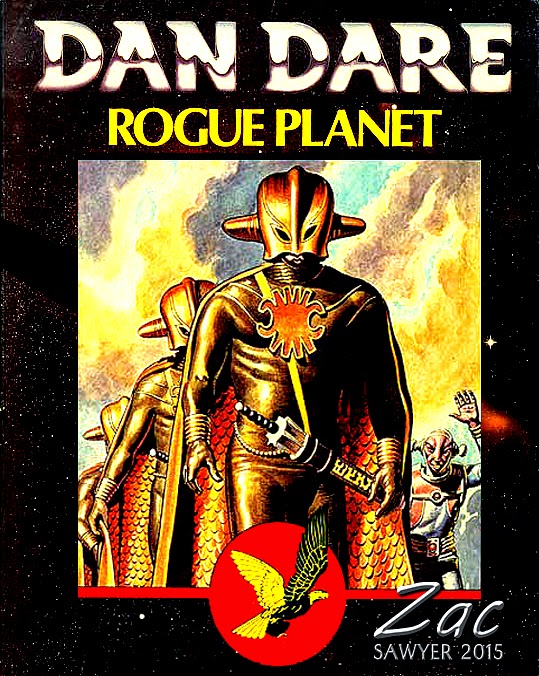 |
| © Copyright Zac Sawyer 2015 |
'Rogue Planet'
There isn’t a moment of pause between 'The Man from Nowhere' and 'Rogue Plane't.
They merge, seamlessly, into one another, the change in story-title the only distinction.
'Rogue Planet' is, however, probably the finer story.
It is not a prelude but a conclusion.
It is a major undertaking, dealing not only with the ending of a war between planets that has lasted for tens of millennia, but it is the overthrowing of slavery, and the establishment and reinforcement of civilization.
Taken all in all, and having regard to the continuing excellent art throughout this story, it’s possible to argue that 'Rogue Planet' is the high point of the entire Dan Dare saga.
Stranks, in this story, handles brilliantly the most serious weakness of the entire set-up, namely the Earth Cryptos expedition itself.
What, of course, is odd is that the aid mission to the Crypts consists of three men and a boy, and they are expected to hold off a planetary invasion.
We, the readers, know that they’ll succeed, but Stranks’ great gift is that he makes that outcome appear utterly plausible.
The action is non-stop: the Crypt ship has been shot down, its passengers and crew have escaped in individual rescue-torpedos and these come to ground on Cryptos, in the jungles of the Wilderness of Wex.
At least, that is, seven do: the capsule containing Flamer Spry cannot be found.
We don’t for one moment, believe that Flamer is dead.
Frank Hampson is not going to kill his audience’s eye-level character, nor is Hulton – or any other publisher of boy’s comics in the mid-Fifties going to allow the death of a thirteen year old boy to happen.
But Flamer is conspicuous by his absence, and Stranks/Hampson have the courage of their convictions to allow six full months to elapse before returning him to the story.
So that makes just three full-grown Earthmen to throw back the Phant Invasion.
But Dan and Co have landed in the Wilderness – and Hampson’s depiction of Cryptos, with its alien flora, fauna and geography, is lush and gorgeous – and this means that they can operate as a guerrilla force, unsuspected by their opponents.
There’s the beginning of the Invasion on the ground, guards and patrols in the woods, and nothing but compliant, passive Crypts.
Which is where Stranks makes the single, most important point of the whole story.
The slim, muscular Phants are a warrior race, but they are not fighters.
Once every 10,000 years, their forces invade a planet that has never raised a finger to stop them.
Their soldiers are slaughterers, and nothing more.
They simply don’t know how to cope with an enemy that fights back.
So, despite the smallness of their numbers, Dan, Dig and Lex are more than a match for any Phant patrols.
Even Lero is moved to grapple with a Phant, preventing him from raising his weapon.
And in this early, exploratory stage of the plot, Stranks introduces what will prove to be the critical element that will allow this tiny band to change the history of the Crypts and Phants.
It’s a very simple thing: with Earth-supplies in very limited quantities, Lex O’Malley offers himself as a guinea-pig to test the Phant food-capsule' however, the purple pills send him into a psychotic rage - from which, however, he subsequently recovers.
But the three Earthmen are far too few to take on the Phant camp, where Crypt slaves are being herded, for transport to Phantos.
Dan swears a vow that he will rescue them all, but in the meantime, all he can do is to undertake a recce, in Phant uniform - which goes badly, because of Stripey.
Stripey is a docile, mammalian Crypt animal, with zebra-like stripes and an elephant’s trunk, who 'adopts' Digby.
Stripey is a cheerful, inquisitive and intelligent animal with a personality of his own, and the improbable little creature becomes an asset in his own right.
However, it’s Stripey’s natural curiosity that proves to be Dan’s undoing, following him into the Phant encampment, only to be picked up by a Phant guard, who threatens to cut his trunk off.
Dan jumps in, causing a commotion that draws the attention of the Phant High Command, Military Commanders Square, Circle and Triangle and Supreme Commander Gogol, a nine feet tall giant.
Despite a few judo tosses to establish who’s who when it comes to grappling, Dan is overwhelmed and taken back to Phantos for dismantling.
'Dismantling', because the Phants are not aware of any intelligent life beyond Los-system so the strange looking, aggressive creature is clearly some form of 'robot', built by the Crypts to do their fighting for them, and as such has to go before the Mystic Orak – the root force behind Phant civilization – so that he can be 'disassembled'.
Digby’s first instinct is to rescue his Colonel, and it takes O’Malley pointing out that he might be ignoring Dare’s final orders to do so.
But dutifully, he and Lex are lead, by Lero, to the centre of Crypt civilization, across a planet that is, in all aspects, beautiful, a luxuriant land of incredible flora and fauna, all of it alien and yet all of it perfectly believable and natural and, in many ways, this marks out Rogue Planet as Hampson’s artistic peak.
Dan, meanwhile, is taken (with the concealed Stripey) to Phantos which, in appropriately symbolic fashion, is a far plainer, far more barren world.
Once he reaches Phantos, he is dragged before the figure that commands the whole of Phantos society, Orak, the mighty Robot-brain.
By the time Dan is dragged before the Orak, a robot brain which is the arbiter of Phant Society, he’s at last growing weak from lack of food, the team having been on restricted rations after losing their supplies when the Crypt ship was shot down.
He’s left alone during Orak’s ‘Hour of Silence’, only to be rescued from the least likely quarter: Flamer Spry.
Flamer’s, of course, has been missing from the story for just over six months, but Stranks/Hampson have judged their moment perfect;y.
In story terms it’s only been a matter of weeks, if as much as that.
The shots that damaged Flamer’s escape capsule knocked it off course, causing him to land on Phantos instead, as indeed did the Crypt ship.
Flamer’s managed not only to keep out of sight but also retrieve the rations from the ship, so Dan can recover his strength, awaiting Orak’s ‘Aqua-Test’, to be followed by 'dismantling'.
It’s a clever twist to have the Phants as vulnerable to water as we are to fire, but it requires a lot of scientific speculation to justify it, and when put into practice, it does give the story some problems.
On a planet that’s as scientifically advanced as Phantos, it’s a little jarring to find that the ‘Aqua-Test’ involves tying Dan’s arms behind his back then lowering him into a countryside river.
Equally, neither Stranks nor Hampson seems comfortable about the implications.
It’s one thing for the story to joke that Flamer has converted one of the weapons into something deadly dangerous to the Phants – a water pistol! – but when the time comes and Dan needs rescuing from Gogol, it is Stripey who intervenes to give Gogol a trunk-full of water smack in the face, causing instant collapse.
Gogol has obviously been killed before our very eyes, but neither Dan nor Flamer react to it, nor will they acknowledge what has happened.
But Gogol is clearly dead: he has no further role in the story despite being supreme military commander.
Dan and Flamer’s next task is to steal Gogol’s ship to rejoin Lex and Dig on Cryptos, where, in accordance with orders, they have been designing a building military defenses in the wake of seeing the Kra leave for its 1,000 year journey through space.
This has unfortunate implications.
Dan and Flamer have prisoners on board, 'Circle' and 'Triangle' (Square has been shot dead by Dan, resisting kidnap).
Now, overflying the city of Chakra, in a Phant ship, they get shot down by one of Dig’s missiles, crash-landing in the bay and having their tables turned when 'Circle' and 'Triangle' grab the guns.
Never mind, Dig and Lex are boating out to rescue them.
As Dig and Lex approach, Dan they shouts out that they are captives, that there are Phants on board controlling them, and to shear off.
Digby and Lex have even seen that there’s a Phant on board, via binoculars.
And they come sailing blithely on.
So the two Phants have all four Crypt ‘Robot-Things’ under guard.
They may have to get through an entire nation of Crypts but their entire history demonstrates that they don’t even need two Phants to cow that many Crypts.
They come ashore at Chakra, smug and secure, except for being so close to water for so long.
'Circle' takes his mask off, and Stripey promptly sprays him in the face, killing him instantly.
Lex’s violent reaction to the Phant food-capsule earlier has given him a theory.
Both types of food-capsule, the purple Phant pills and the yellow Crypt pills have been analysed and found to consist of different nutrients.
It’s possible that it is the diet that is the direct cause of Phant aggression and Crypt fear, so Lex has had the Crypt scientists make a batch of Crypt capsules in purple.
They feed these to 'Triangle', and within 24 hours he is as docile and peaceful as any Crypt.
What remains is to switch the entire Phant food production to Crypt capsules, first for the invasion force on Crypt, then on Phantos itself.
There are twists and turns and obstacles to be negotiated, not least of which is 'Triangle' himself, so is far converted to the cause of peace that he’s almost become a 'hippie' who can’t help himself from trying to convert Phants to the cause before altering their diets.
At last though, the plan succeeds.
Orak is exposed for what he is, an outmoded robot created by the cultish warrior-priests, the Kruels, and the Phants turn peaceful
The Kra is recalled, and Lero sets off to commit suicide in space.
He’s relieved of this obligation, imposed by the mores of Crypt society, by Dan’s forgiveness of his most serious crime: he has lied to a friend.
And it is a most serious lie, with massive consequences, one whose truth Dan keeps to himself until the team is en route home for Earth.
And so, when they get back, they have not been gone for a few months only, because Lero lied.
The Crypts, it appeared, had not conquered ‘faster-than-light’ propulsion, and the ‘acceleration/deceleration’ chambers were no such thing, but rather suspended animation chambers.
So when Dan and Co return to Earth, in the final panel of the final page, they find that they have been gone for ten years.
Rogue Planet is probably the finest period in the strip’s history.
It’s not just the detail, lush and brilliant as it is without ever once overriding the central image of each panel.
It’s not just the skill and deftness with which Hampson composes first his pages, then his panels.
It’s not just the invention that creates alien worlds, truly alien worlds, that glow with life, that look real, that look lived in, that make you want to climb inside the panels and go exploring yourself.
But perhaps above all of this, it’s the coloring.
Each page is a riot of color, bright, harmonious, three-dimensional.
Cryptos becomes that very real world.
Hampson renders his heroes in contrasting colors that identify them wherever they are: Dan in his Space-fleet green uniform, Flamer in Astral blue.
Lex, with his Naval Cap and his mariner’s roll-neck thick white jersey, and Digby, caught in civvies, a red and yellow check shirt and white beach shorts.
Much of this has to do with Hampson reaching his artistic maturity, but much is also due to the presence of Don Harley, ‘the second-best Dan Dare artist in the world’, and also to a tightly organised, largely settled studio that, though still working hard, was not pulling the same kind of twenty-four hour grind of old.
The studio was working, and Hampson was able to rely upon them.
He had a writer he could trust, who enabled him to devote more time to his art.
to view images full size open image in a new tab
A HUMEROUS 'TAKE' ON THE PLOT OF 'ROGUE PLANET'
(with our old friend 'The Mekon')
Comment on 'Flamer' Spry
There is, undoubtedly, an incongruity of Flamer Spry’s presence on both the undersea expedition in Lex O’Malley’s 'Poseidon', and as one of the four man Earth Expedition across interstellar space to the planet Cryptos, to save the peaceful Crypts from invasion, slaughter and slavery at the hands of their war-like enemies, the Phants.
Now in any kind of realistic frame, should Flamer have gone on the Cryptos Expedition, or Poseidon exploration ?
It is important to remember that he is presented as a thirteen year old boy, and while one can understand and appreciate the commercial appeal of including a member of Eagle‘s audience directly in the story, the fact remains that Frank Hampson never touches on why this young boy should form an integral part of so many adventures.
It could be possible to gloss over this, and in a lesser series that would be easy, but Hampson has set standards of realism, in art and story construction, that do not allow one to ignore flaws and weaknesses in the logic of his world.
It was one thing for Flamer to play a substantial role in 'Prisoners of Space'.
His introduction in that story was logical, well-planned, and the result of a perfectly believable accident.
And it was equally proper for Flamer to be at the Embassy Reception, and enjoy recognition for his part in what occurred.
Note though that, when the alarm sounded, and Dan left to fly off with the interceptor squadron that Flamer was rightly not among the crew.
That Lex O’Malley, who’s known Dan for maybe a half hour, does go with the interceptor squadron is odd, to say the least.
The one big question, however, that’s never answered in all the stories in which he appears is just who the Junior Cadet nicknamed 'Flamer' Spry is in the first place.
'Flamer' appears out of nowhere, along with Astral College and all its other cadets, Senior and Junior, in the first episode of 'Prisoners of Space'.
There’s no suggestion that Dan Dare has even heard of him before 'Flamer’s' model rocket ship nearly prangs Sir Hubert, but Dan is sufficiently impressed by the young boy that he ‘punishes’ him by giving him a tour of the real thing.
All of this is perfectly plausible, and given how well 'Flamer' conducts himself in difficult circumstances, it’s entirely understandable that Dan might then look upon him as a sort of protegé.
In that light, the decision to wangle a place for 'Flamer' on the 'Poseidon' expedition – a non-combat, search-and-rescue mission, – is equally understandable, and even logical.
It’s what follows that stretches credibility, and raises some difficult questions.
Dan is off to Cryptos, across interstellar space, with three volunteers, one of whom is going to be, inevitably, Digby.
That 'Flamer' should put himself forward as a volunteer is only to be expected, however, the odd result is that he’s accepted: a thirteen year old boy on a potentially suicide mission, traveling to avert war five light-years from Earth?
Now 'Flamer' is an approximately thirteen year old boy at Astral College, a full-time, military-based establishment, and like a boarding school pupil, he lives in.
The College is 'in locus parentis'.
In practice, 'in locus parentis' would mean the Headmaster, and via devolved authority, the masters. Ultimately, the responsibility vests in the Controller of Spacefleet, Sir Hubert Guest, who is also the supreme authority on Dare’s Expedition.
Sir Hubert’s response of course is obvious one: 'No'.
But he is persuaded to relent, and to authorize Flamer’s admission, by a speech from the young man.
What does 'Flamer' say that convinces Sir Hubert, against his own better judgement, to allow him to go ?
It’s made up in equal parts of positive and negative arguments.
The positive arguments are what you would expect in the circumstances: the opportunity, to see, to experience, to grow and to bring back to his classmates everything he learns.
But it is the negative argument that is unusual.
It’s basically a statement of the complete un-importance of 'Flamer' Spry.
Who is he ? Nothing but a single Astral College cadet.
If he should die, what has been lost ? Just one, tiny, insignificant figure, less than nothing in the grand scheme of things.
It’s an impressive argument, but it is difficult to believe that a thirteen year old boy should have, let alone speak such thoughts.
In their way, they speak to a 'nobility' that is in keeping with Dan Dare himself, but which sits awkwardly with so young a figure
But the statement is fateful in calling our attention to the complete blackout of everything that lies behind 'Flamer’s' debut in 'Prisoners of Space'.
When he describes himself as nothing, as someone whose death would cause no loss, create no absence, leave no trace behind, it draws attention to that imposing lacuna: who is Flamer Spry?
He must have had parents - but who are they ? Where are they ? What’s happened to them ?
And whilst there must have been Grandparents, are there other relatives ? Brothers and sisters ? Aunts and Uncles ? Cousins ?
Is 'Flamer' Spry really so alone in the world that there is no-one outside of Astral who has any interest in what might be his fate ?
Though Frank Hampson began Dan Dare with detailed biographies of its principal characters, there does not seem to have been anything similar prepared in respect of 'Flamer' Spry.
It’s been tentatively suggested that perhaps Dan knew the Spry parents, and Flamer when he was very young, and that he has taken an avuncular stance in relation to him.
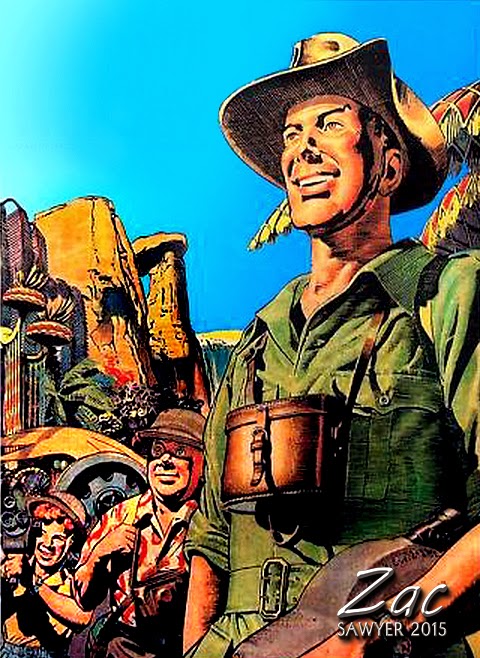 |
© Copyright Zac Sawyer 2015
'Flamer' on holiday with Dan and Digby |
It’s a simple construct, and perhaps the Spry parents died when Flamer was young, or are stationed on Mars, or else working in some element of the Service that provides an equivalent to the Twentieth Century manner of getting unwanted parents out of the way, running Rubber Plantations in Malaya, or on diplomatic missions with the Foreign Service.
Regardless, we are left with the question of why Earth’s Chief Pilot of Spacefleet hangs around an awful lot with a thirteen year old boy - because that really is the problem.
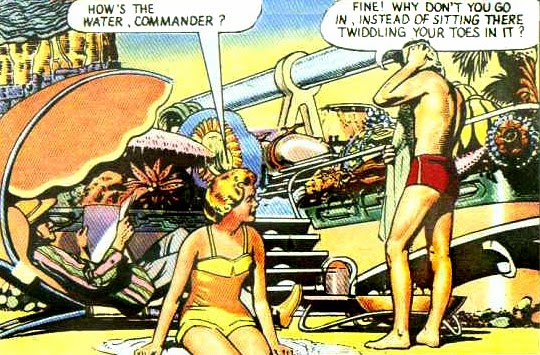 |
| Prof Peabody, O'Malley and Sir Hubert on Holiday |
And one must also consider that when Dan gets some leave, he takes 'Flamer' on holiday with him to the South of Venus (while Peabody and O'Mally holiday seperately in Mekonta).
A similar situation may be found with two other characters appearing in boy's comics - Batman and Robin, Bruce Wayne and Dick Grayson.
The 'Dynamic Duo' may well be seen as portraying an idealized homoerotic life-style, the man and his underage boy spending all their time living in a house with no female element.
In a similar manner, we have a relationship between a tall, handsome male bachelor who has demonstrated a lack of interest in any female company (Professor Peabody).
He already spends all his life with a devoted male, (like Batman), who has apparently abandoned his wife and children to serve him.
And now this ‘confirmed bachelor’ suddenly starts taking around with him a thirteen year old boy.
Unfortunately, there’s not an answer or a definitive conclusion to this.
One has to consider, of course, whether any conscious undertones were intended.
But with all those slim, gym-toned and muscled Phants running around, one can't help but wonder.
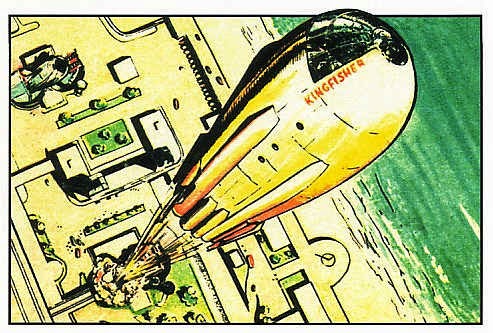

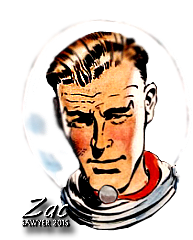










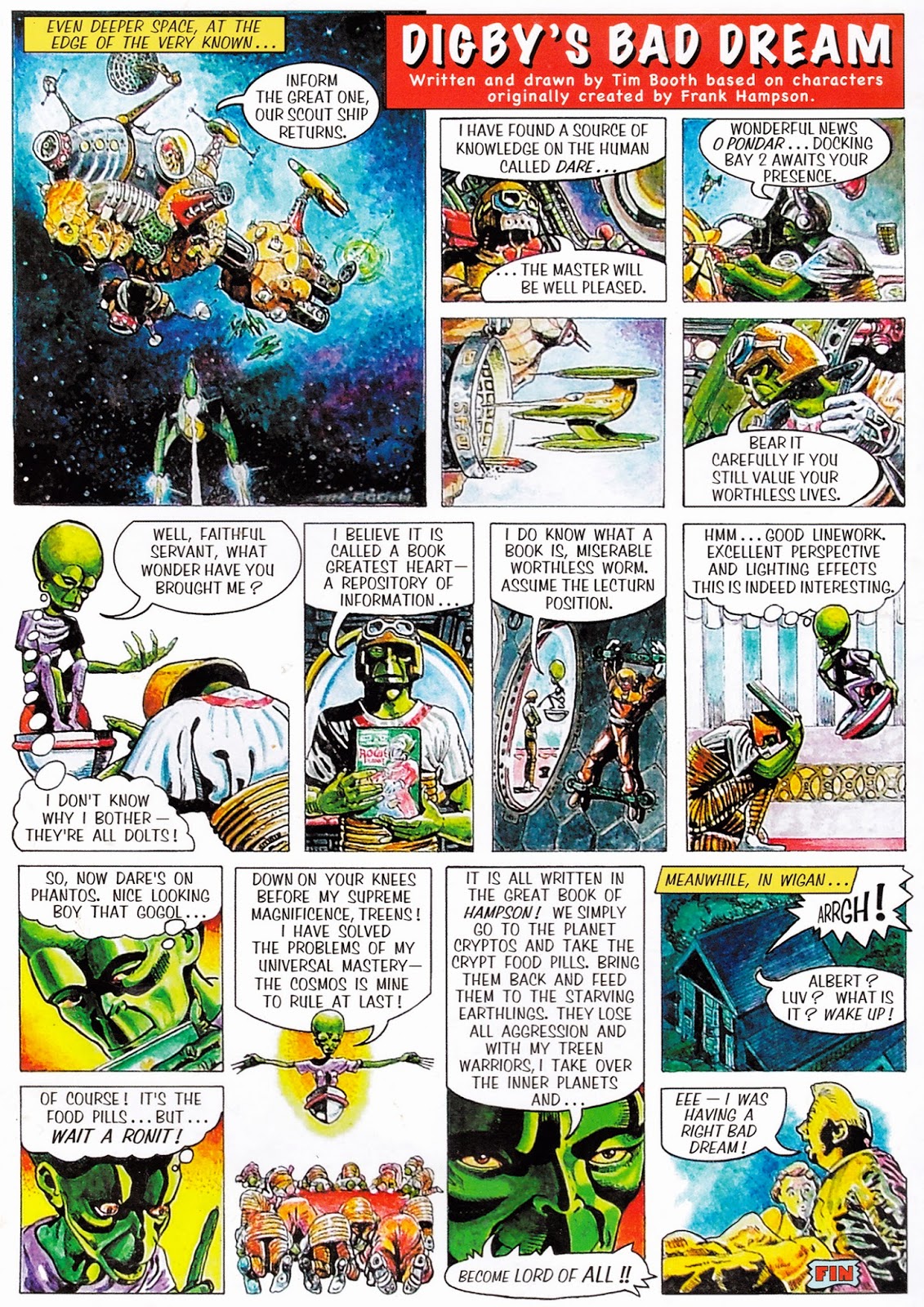
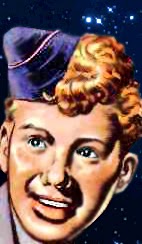
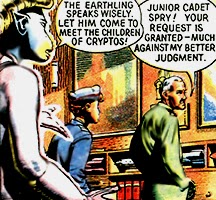


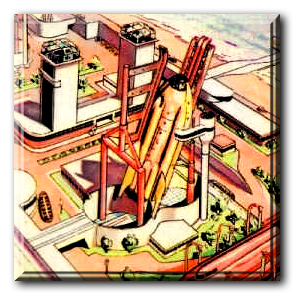




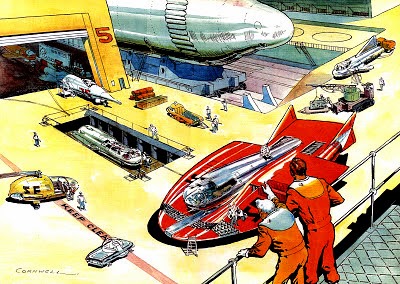
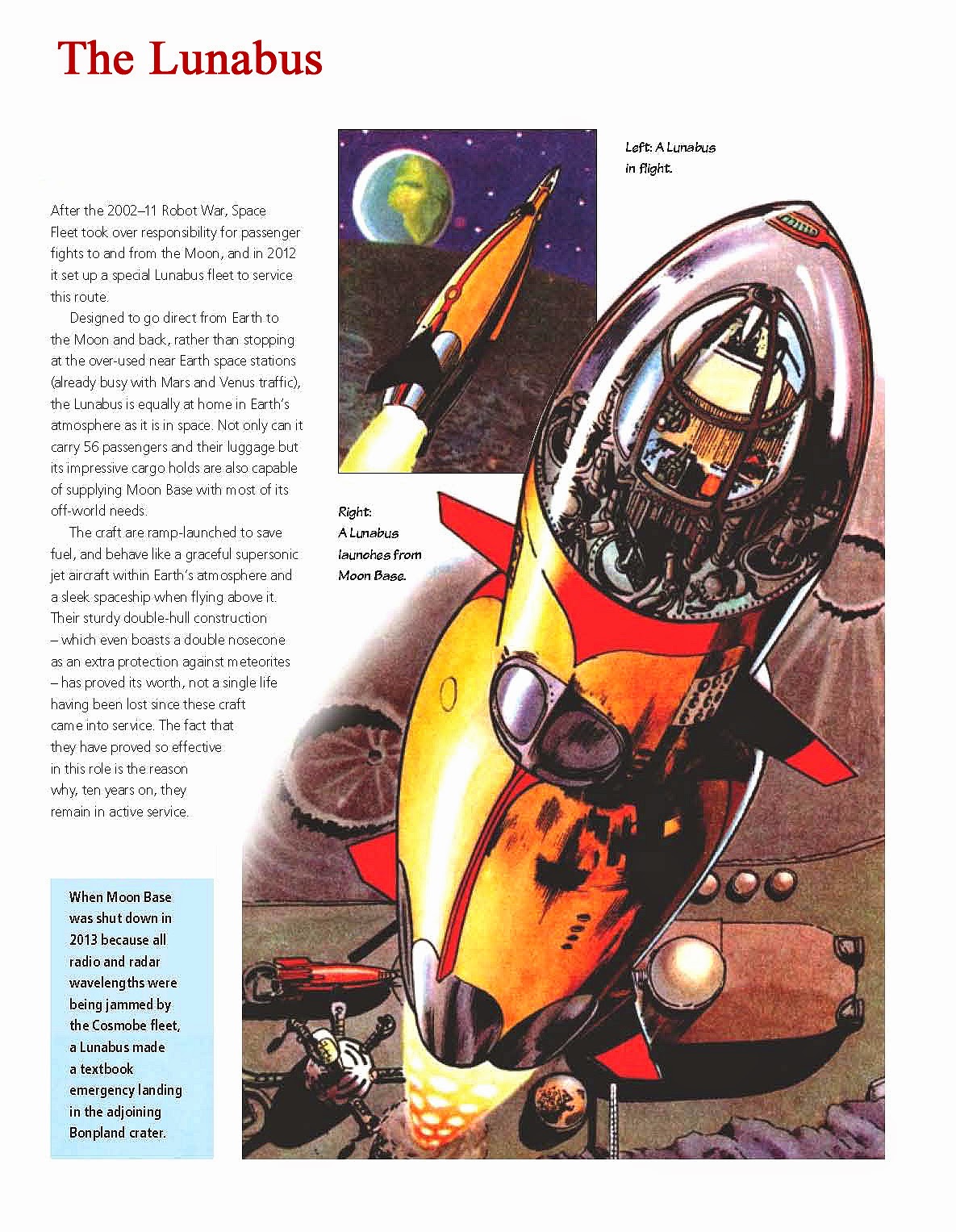
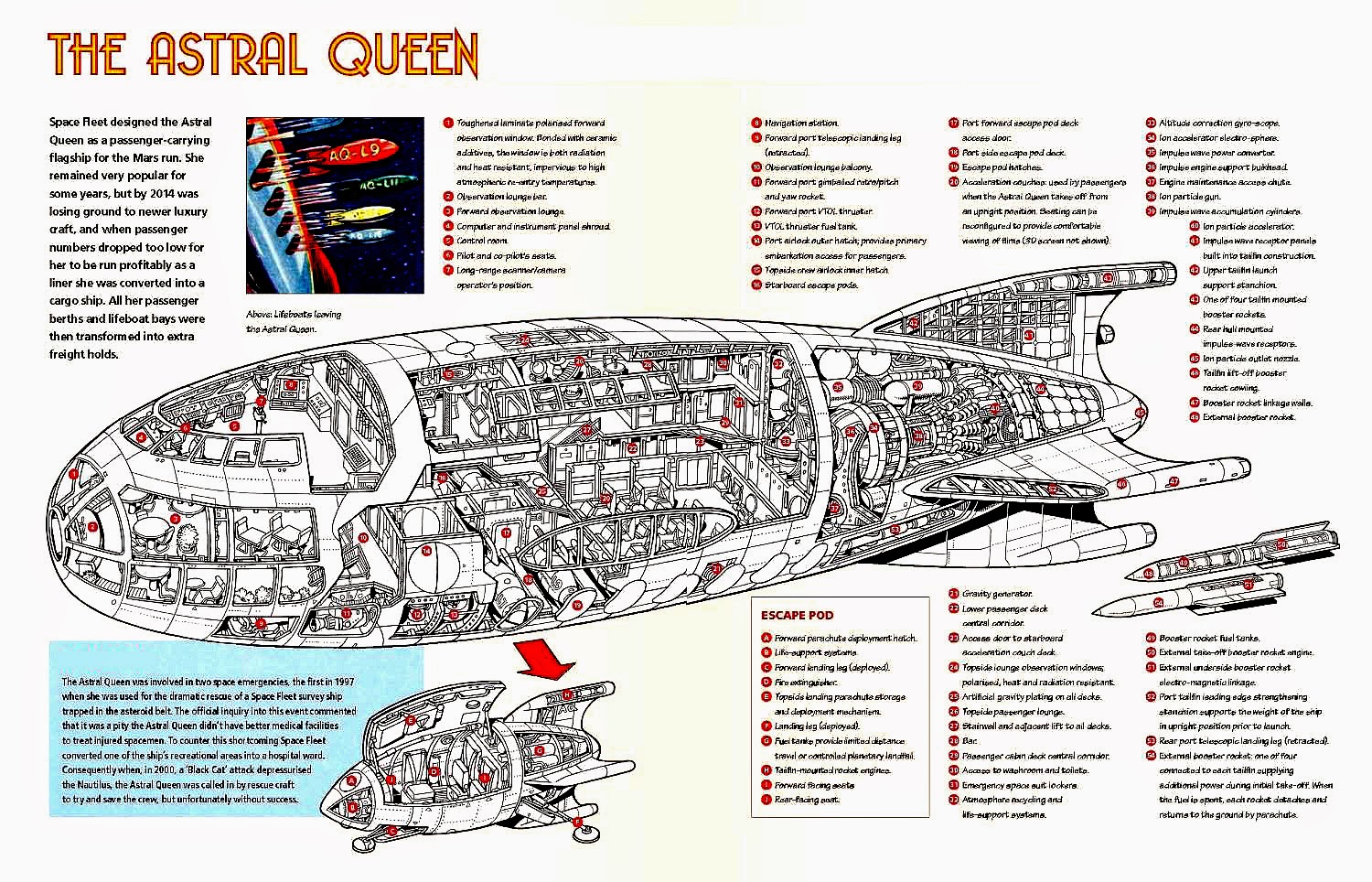
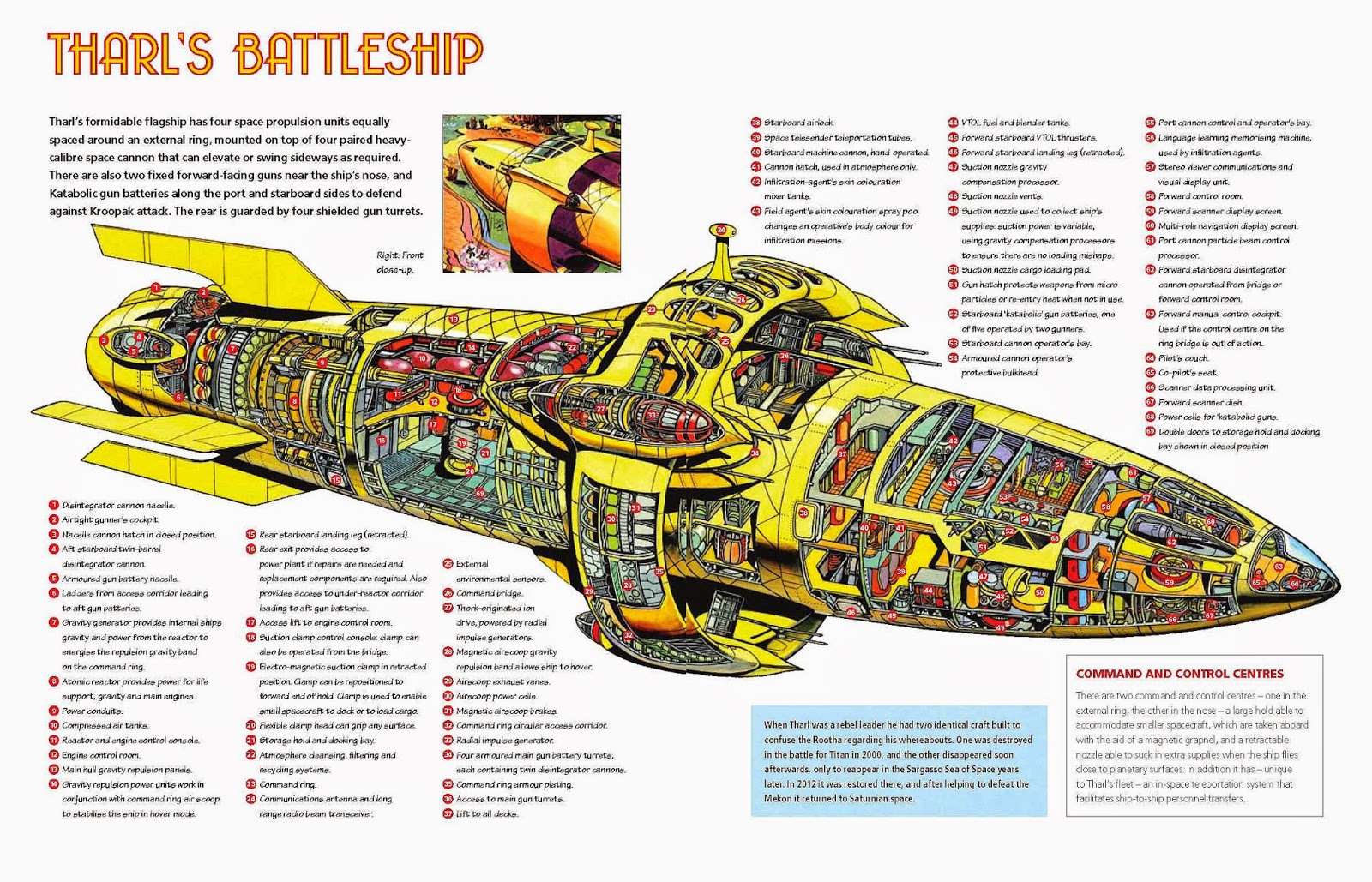
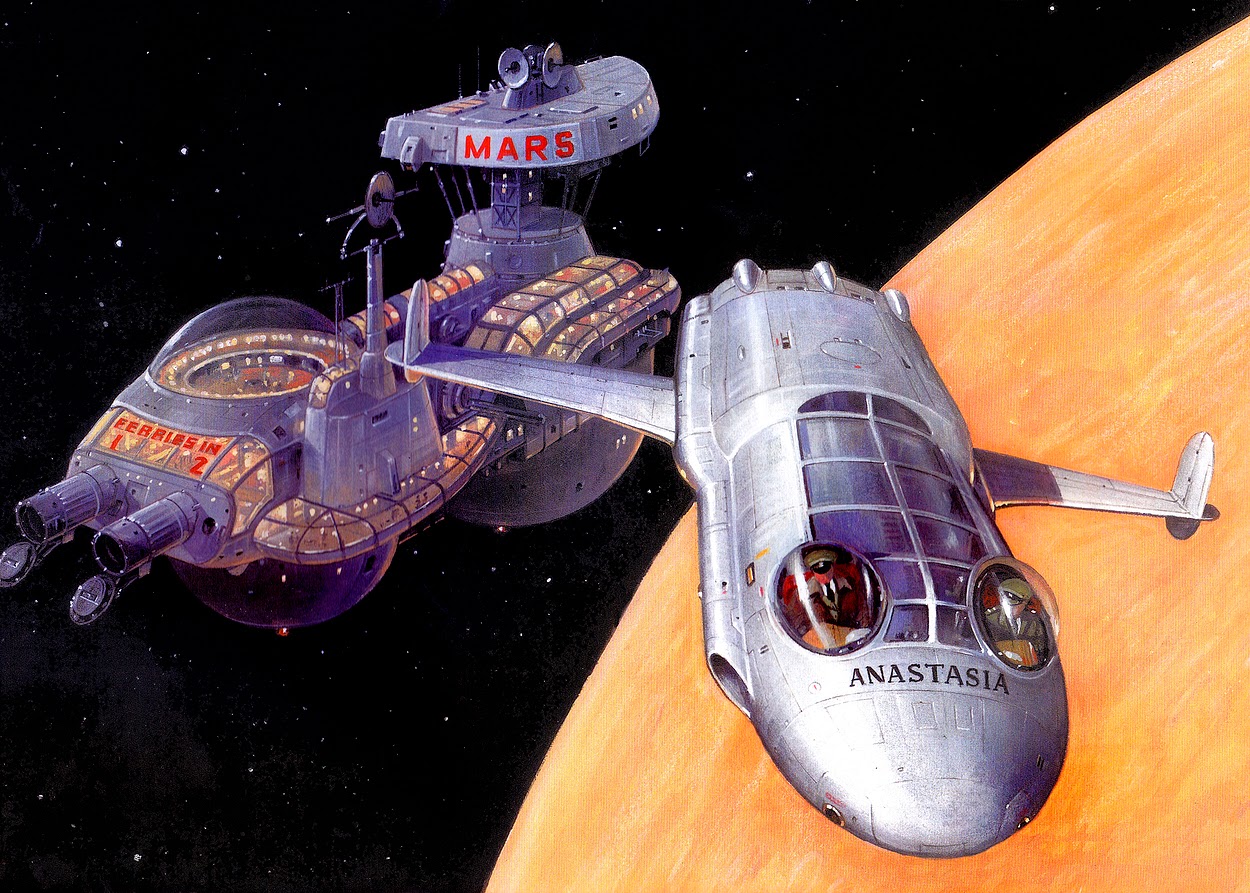%2B(adapted%2Bfrom%2BSpaceships%2BAway)%2B%2B-%2BFrank%2BHampson%2B-%2BDan%2BDare%2B-%2BZac%2BSawyer%2B2015.jpg)
%2B%2B(adapted%2Bfrom%2BSpaceships%2BAway)%2B-%2BFrank%2BHampson%2B-%2BDan%2BDare%2B-%2BZac%2BSawyer%2B2015.jpg)
